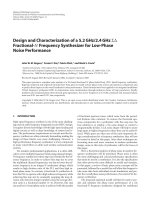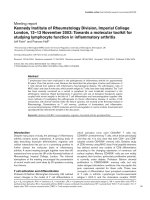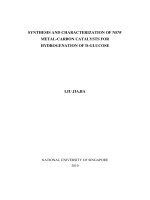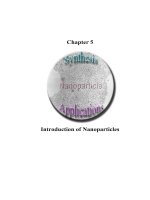Synthesis and characterization of group 11, 12 and 13 metal selenocarboxylates potential single molecular precursors for metal selenide nanocrystals 3
Bạn đang xem bản rút gọn của tài liệu. Xem và tải ngay bản đầy đủ của tài liệu tại đây (11.16 MB, 69 trang )
Chapter 8 ZnSe & CdSe NPs
120
Chapter 8. Synthesis of ZnSe and CdSe NPs from
Neutral Zn(II) and Cd(II) Selenocarboxylates
8.1 Introduction
ZnSe is a wide band gap (2.7 eV) semiconductor.
142
Due to the quantum
confinement effect, their NCs are interesting emitting materials in the blue to the ultra
violet range.
116
To date, many syntheses on ZnSe NP have been reported. Briefly,
Peng and his co-workers have synthesized highly monodispersed ZnSe QDs from
ZnO precursor in noncoordinating containing fatty acid or amine.
116
Recently, an
Italian research group has managed to control the morphology and phase of the ZnSe
NCs by conducting the reaction in long-chain alkylamines and alkylphosphines.
143
In
addition, aqueous soluble ZnSe NP has been prepared by Alexander et al. and they
have found that post-preparative irradiation on the synthesized ZnSe NPs greatly
improve their luminescence quantum yield.
144
A simple one-pot synthesis of ZnSe NP
by thermally decomposed the diselenocarbamate precursors in TOP/TOPO has been
reported by O’Brien group few years ago.
78, 145
CdSe semiconductor has a much narrow band gap (1.74 eV) as compared to
ZnSe. Till today, CdSe QD remains an interesting material due to quantum size
effects,
146
the band gap of CdSe NCs increases as their size decreases, and thus the
emission color of the band-edge PL of the NCs shifts continuously from red (centered
at 650 nm) to blue (centered at 450 nm) as the size of the NCs decreases. Many
applications have been emerged from this remarkable property of CdSe NPs.
66
CdSe
NCs with close to monodispersed size distribution and high crystallinity became
available in the early 1990s by use of dimethylcadmium as the cadmium precursor.
67,
Chapter 8 ZnSe & CdSe NPs
121
147
This organometallic approach has been well developed during the past 10 years in
terms of the control over the size,
10
shape,
72, 101, 120, 148
and size/shape distribution of
the resulting CdSe NCs. Besides, O’Brien group also demonstrated that high quality
CdSe NCs can be obtained through single source precursor method.
78, 79, 149
The use of single-source molecular precursor, as initially reported by O’Brien
et al., had proven to be an efficient route to high quality, crystalline monodispersed
NPs of semiconducting materials.
78, 79, 145, 149
Further, Hampden-Smith and our
laboratory have demonstrated that high quality group 12 metal sulfides can be
synthesized from metal thiocarboxylates.
84, 85
Therefore, in this chapter, we will
explore the synthesis of ZnSe and CdSe NPs using two neutral metal
selenocarboxylate precursors we have prepared, namely, [Cd(SeC{O}Ph)
2
] and
[Zn(SeC{O}Tol)
2
]·(H
2
O). The optical property of the synthesized NPs has also been
presented.
The purpose of using the neutral metal selenocarboxylate over
[M(TMEDA)(SeC{O}R)
2
] or [M(2, 2’-bipy)(SeC{O}R)
2
] is to avoid TMEDA and
2, 2’-bipy which can also compete with other capping agents. These neutral metal
selenocarboxylates eliminate the influential contribution of these additional capping
agents on the shape, size and properties of the NCs synthesized. This will help us to
further advancement of knowledge in this bottom-up approach to metal selenide NCs.
8.2 Results and Discussion
Fast injection of precursor into hot surfactant at elevated temperature can lead
to a sudden burst of monomers followed by an instantaneous and short nucleation.
This is one of the most important criteria in order to produce a monodispersed NPs
which many research groups have demonstrated this in the past.
10, 66, 67, 72, 101
TOP is
Chapter 8 ZnSe & CdSe NPs
122
commonly used in the nanosynthesis due to its high boiling nature. Besides, it can
also stabilize a wide range of complexes in solution, unlike the long chain amine
which decomposed the precursor at room temperature.
86, 87
We found that
[Zn(SeC{O}Ph)
2
] precursor is not soluble in TOP, thus we didn’t use this precursor in
our studies.
8.2.1 Optical Properties of ZnSe NPs
In many occasions, high quality CdSe NPs were synthesized from the
combination of TOP and TOPO surfactants.
10, 67, 72, 101
However, we were unable to
synthesize good quality ZnSe NPs from [Zn(SeC{O}Tol)
2
]·H
2
O under similar
conditions. In most cases, a colorless solution was obtained and based on the reported
syntheses, a yellow solution, indicates the formation of ZnSe NCs, should have
formed after the injection of precursor.
143, 144
In addition, no precipitate was obtained
by adding large amount of MeOH to this colorless solution. Thus it is suspected that
the precursor has decomposed in the TOP/TOPO solution, reacted with the surfactants
and formed a stable inorganic complex which has a very good solubility. Varying the
amount of TOP, TOPO and reaction temperature did not change the result. In fact,
similar phenomenon was observed by Philippe and Margaret when they tried to
synthesize ZnSe from diethyl zinc in TOP/TOPO solution.
150
According to them, the
dispersed NCs are too small that they cannot be isolated by standard
solvent/nonsolvent precipitation.
HDA is another high boiling surfactant that has been
used extensively for the preparation of various semiconductor NPs.
87, 91, 150
When the
TOP solution of [Zn(SeC{O}Tol)
2
]·H
2
O was injected into hot HDA solution,
immediately clear yellow solution was observed indicated the formation of ZnSe NP.
However, the NPs were unstable in the HDA solution and precipitated out in less than
Chapter 8 ZnSe & CdSe NPs
123
5 min. An additional of TOPO surfactants was found to improve the stability of the
NPs in the reaction solution.
The ZnSe NPs were first synthesized at 220 ºC with the molar ratio of
precursor to HDA to TOPO fixed at 1:7.4:15.5. The growth of the ZnSe NPs was
monitored by recording the optical spectra after 5 min, 15 min and 30 min and the
evolution of the absorption spectra over time for ZnSe is shown in Figure 8.1. Direct
band gap method
142
was used to calculate the approximate band edge of different
ZnSe samples.
The detailed steps in deriving the band edge from UV-vis spectrum is
shown in the appendix section.
Figure 8.1. UV-absorption spectra of ZnSe NPs taken at different time intervals (The
absorption spectra at 15 and 30 min are identical).
From the absorption spectra, it clearly showed that all the samples have
similar band edge (2.83 eV) and size (4.8 nm). Thus this indicated the ZnSe NPs do
not undergo Osward ripening when the heating is prolonged.
151
Macrocrystalline
ZnSe has an optical band gap of 2.58 eV (480 nm) at room temperature.
142
Hence, the
band edges for these samples are blue-shifted in relation to the bulk. Further, the blue
shift is associated with the ZnSe NPs being smaller than the bulk ZnSe. The
Chapter 8 ZnSe & CdSe NPs
124
photoluminescence spectra of these samples show a broad band edge emission
maximum at 436 nm (λ
exc.
= 381 nm) as shown in Figure 8.2.
Figure 8.2. Photoluminescence spectrum of ZnSe NPs at different time internals.
The emission peaks are slightly red shifted in relation to the band edge and
this could be attributed to recombination from surface traps.
152, 153
A shoulder at 463
nm was observed in the emission spectra of ZnSe NPs and could be due to the deep
trap emission. Unfortunately we were unable to identify the emission peak at 413 nm.
In fact, similar emission peak has been observed for ZnSe NP by O’Brien’s group.
78,
145
According to them, this peak could be attributed to the concentration of NPs in
solution was too high which cause a re-emission or the recombination of surface traps.
Varying the concentration of HDA and growth temperature do not affect the size of
the ZnSe NPs based on the approximate size calculated from UV absorption spectra
as shown in Figure 8.3
.
Chapter 8 ZnSe & CdSe NPs
125
Figure 8.3a. UV-absorption spectra of
ZnSe NPs isolated at various temperatures
after 5 min of heating.
Figure 8.3b. UV-absorption spectra of
ZnSe NPs isolated at various HDA
concentration after 5 min of heating.
8.2.2 Optical Properties of CdSe NPs
An immediate color change from yellow orange to red was observed when the
TOP solution of [Cd(SeC{O}Ph)
2
] was injected into TOPO (0.8 g) at 220 ºC,
indicating the formation of CdSe NPs. The estimated size for the CdSe NPs using the
direct band gap method
142
for the sample isolated at 10 and 20 min are 8.8 nm (1.84
eV) and 8.9 nm (1.83 eV) respectively. When the experiments were repeated with the
addition of trace amount of HPA (44.68 mg), we noticed a drastic improvement on the
quality of the CdSe NP was noticed as shown in Figure 8.4. As mentioned earlier,
Alivisatos et al. have noted that the presence of HPA has improved the growth of
CdSe NPs.
7
Overall, smaller size CdSe particles were obtained based on the blue shift
of UV-absorption spectra of the samples isolated at 10 (2.06 eV, 5.6 nm) and 20 (2.05
eV, 5.7 nm) min intervals. Further, the obtained CdSe NPs are monodispersed as the
patterns of obtained UV-absorption spectra are resembled to those that reported for
monodispersed CdSe NPs.
72, 101
A sharp peak at ≈ 433 nm could be assigned to the
higher spin-orbit component of the 1s – 1s transition.
154
Chapter 8 ZnSe & CdSe NPs
126
Figure 8.4. Optical absorption spectra of CdSe NPs synthesized with/without HPA.
To examine the effect of HPA on the growth of CdSe NPs, the samples were
synthesized in various HPA concentrations and absorption spectra of the 10 min
samples where recorded. The UV-absorption spectra of these samples were compiled
in Figure 8.5. Clearly shown in Figure 8.5, that minimum amount of HPA (e. g., 44.68
mg) is sufficient to produce high quality CdSe NPs. Further, increased the HPA
concentration doesn’t lead to smaller CdSe NP. This finding is consistent with those
reported by Alivisatos et al.
72, 101
Chapter 8 ZnSe & CdSe NPs
127
Figure 8.5. Uv-absorption spectra of CdSe NPs synthesized at different HPA
concentration.
Based on the UV-absorption spectra, varying the TOPO amount (the molar
ratio between HPA and TOPO is maintained at 1.5) and growth temperature do no
affect the size of the CdSe NPs as shown in Figure 8.6. However, we noticed that
samples that prepared at higher temperature and high TOPO concentration are more
stable after they were redispersed in toluene.
Figure 8.6a. UV-absorption spectra of
CdSe NPs isolated at different
temperature after 5 min of heating.
Figure 8.6b. UV-absorption spectra of
CdSe NPs isolated at different TOPO
concentration after 5 min of heating.
Chapter 8 ZnSe & CdSe NPs
128
The optical absorption spectra of the CdSe measured over time period are
shown in Figure 8.7. The optical absorption edge 2.14 eV (t = 5 min, 580 nm) shows a
blue shift in relation to bulk CdSe, 1.73 eV (716 nm). The band edges of the
subsequent samples are as follows: 2.04 eV (t = 10 min, 607 nm); 2.01 eV (t = 15
min, 617 nm). While the calculated diameter for all the samples are as follows: 5.1 nm
(t = 5 min); 5.8 nm (t = 10 min) and 6.0 nm (t = 15 min). Unlike the ZnSe, the size of
CdSe grows larger as the time of heating is increased. The photoluminescence
spectrum of CdSe (t = 5 min) shows a red shift in relation to the corresponding optical
spectra as show in Figure 8.8. The photoluminescence peak is narrow with an
emission maximum at 565 nm (λ
exc.
= 450 nm). In the case of CdSe, no deep-trap
emission is observed in the photoluminescence spectra.
Figure 8.7. Optical spectra of CdSe NPs taken at different time intervals (250 ºC; 2.6
g of TOPO; 44.7 mg of HPA).
Chapter 8 ZnSe & CdSe NPs
129
Figure 8.8. (a) Optical absorption (blue) and (b) photoluminescence (red) spectra of
CdSe NPs. (t = 5 min).
8.2.3 Structural Characterization of ZnSe and CdSe NPs
The XRPD spectra of the synthesized ZnSe and CdSe NPs are shown in
Figure 8.9. All the peaks can be indexed according which correspond to cubic phase
ZnSe (JCPDS No. 037-1463) and hexagonal phase CdSe (JCPDS No. 08-0459). The
broadening of the XRPD peaks as compared with the bulk is due to the smaller size of
the NPs. In addition, the broad diffuse rings observed in the SAED patterns (as shown
in Figure 8.10) also support the fact that the small size of ZnSe and CdSe NPs.
Chapter 8 ZnSe & CdSe NPs
130
Figure 8.9. XRPD patterns of ZnSe and CdSe NPs.
Figure 8.10. SAED of (a) ZnSe and (b) CdSe.
The TEM images of ZnSe and CdSe NPs isolated after 5 min of heating are
shown in Figure 8.11 and 8.12. The size of the ZnSe and CdSe NPs measured from
the TEM image based on 300 NPs are 7.3 ± 1.1 nm and 4.4 ± 0.5 nm respectively.
The synthesized ZnSe and CdSe NPs are crystalline as clear lattice fringes of these
NPs are visible in the HRTEM images. The EDAX analysis on these NCs confirmed
the presence of the respective metal and selenium with ratio close to 1:2. Further,
Chapter 8 ZnSe & CdSe NPs
131
phosphorus peak is observed in the EDAX spectra as shown in Figure 8.13, which
indicated the NC could be capped by TOP and/or TOPO. The infrared spectrum of the
ZnSe NPs (Figure 8.14) show a broad band at 1078 cm
-1
(υ
sym
Zn–O–P), a shift of 68
cm
-1
from the characteristic stretch for TOPO (υ
sym
O–P, 1146 cm
-1
),
145
which
indicated that the NPs are capped by TOPO. Similarly, the O=P stretching in the IR
spectrum of CdSe NPs also shifted to 1105 cm
-1
(υ
asym
Cd–O–P) and 1032 cm
-1
(υ
sym
Cd–O–P) indicating that the NPs are capped by TOPO.
Figure 8.11. (a) Low resolution and (b) high resolution TEM images of ZnSe NPs. (c)
The size distribution of the ZnSe NPs.
Chapter 8 ZnSe & CdSe NPs
132
Figure 8.12. (a) Low resolution and (b) high resolution TEM images of CdSe NPs.
(c) The size distribution of the CdSe NPs.
Figure 8.13. EDX of (a) ZnSe, (b) CdSe NPs.
Chapter 8 ZnSe & CdSe NPs
133
Figure 8.14. IR spectra of TOPO, ZnSe and CdSe NPs.
8.3 Summary
Monodispersed ZnSe and CdSe NPs have been synthesized from
[Zn(SeC{O}Tol)
2
]·H
2
O and [Cd(SeC{O}Ph)
2
] in TOP/TOPO/HDA and
TOP/TOPO/HPA surfactants respectively. In this study, it is found that trace amounts
of HDA and HPA are crucial for the formation of high quality ZnSe and CdSe NPs. In
the case of ZnSe, a broad emission peak was observed which could be due to the deep
trap emission or the recombination of surface trap. In contrast, the synthesized CdSe
NPs show a promising luminescence property. EDX and IR studies has confirmed the
surfaces of these NPs are capped by TOPO. Our study shows ZnSe and CdSe NPs that
obtained through injection method from neutral metal selenocarboxylates were having
better size distribution than those that was previously synthesized from [(2, 2’-
bipy)M(SeC{O}R)
2
] single-source precursors by our group.
155
Thus, the choice of
precursor has great influence on the growth of the NPs.
Chapter 8 ZnSe & CdSe NPs
134
8.4 Synthesis and Methodology
8.4.1 Synthesis of [Cd(SeC{O}Ph)
2
] and [Zn(SeC{O}Tol)
2
]·(H
2
O)
The syntheses of Na
+
TolC{O}Se
–
and Na
+
PhC{O}Se
–
are described in chapter 2 and
3 respectively.
[Zn(SeC{O}(Tol)
2
]·H
2
O, 12 The MeCN in [Na
+
TolC{O}Se
–
] (4.00 mmol) solution
was removed to dryness under vacuum. 30 mL of degassed H
2
O was then added to the
crude sodium monoselenocarboxylate and the insoluble precipitate was filtered off.
ZnCl
2
(0.27 g, 2.00 mmol) dissolved in degassed H
2
O (10 mL) was added dropwise to
the yellow filtrate and a pale yellow precipitate formed immediately. The solution was
stirred for 1.5 hours at room temperature and the pale yellow precipitate was filtered
off and washed with plenty of H
2
O to removed the unreacted ZnCl
2
and
[Na
+
TolC{O}Se
–
], then it was dried under vacuum and stored at 5 °C for further use.
Yield: 0.850 g (92 %). Elemental Anal: Calcd. for ZnSe
2
C
16
H
14
O
2
.H
2
O
(mol wt
479.61): C, 40.07; H, 3.36 %. Found C, 40.31; H, 3.30 %.
1
H NMR (d
6
-DMSO) δ
H
:
2.35 (6H, S, CH
3
–C
6
H
4
C{O}Se), 7.23 (4H, d, J = 6 Hz, meta-proton), 7.95 (4H, d, J =
6 Hz, ortho-proton).
13
C NMR (d
6
-DMSO) δ
C
: 207.2 (TolC{O}Se), 141.5 (C
4
), 140.7
(C
1
), 128.5 (C
2/6
or C
3/5
), 127.9 (C
3/5
or C
2/6
), 21.3 (CH
3
–C
6
H
4
C{O}Se). ESI-MS (DMSO):
m/z 661.0 ([Zn(SeC{O}Tol)
3
]
-
, 100%), 1120.1 ([Zn(SeC{O}Tol)
2
]
2
+ TolC{O}Se
-
,
100%), 199.3 (TolC{O}Se
-
, 30%). TGA for one H
2
O: 3.75 % (Calc.); 3.56 % (Obs.).
[Cd(SeC{O}Ph)
2
], 13 The synthesis of 13 is similar to 12 except CdCl
2
and
[Na
+
PhC{O}Se
–
] were used in the preparation. Yield: 89%. Elemental Anal: Calcd.
for CdSe
2
C
14
H
10
O
2
(mol wt 480.56): C, 34.99; H, 2.10 %. Found C, 34.65; H, 1.78 %.
1
H NMR (d
6
-DMSO) δ
H
: 7.96 (4H, d, J = 9 Hz, ortho-proton), 7.58 (4H, t, J = 9 Hz,
para-proton), 7.45 (4H, t, J = 6 Hz, meta-proton).
13
C NMR δc (d
6
-DMSO): For
Chapter 8 ZnSe & CdSe NPs
135
selenobenzoate ligand: 127.12 (C
2/6
or C
3/5
), 128.61 (C
2/6
or C
3/5
), 131.05 (C
4
), 142.94
(C
1
), 201.50 (COSe). ESI-MS (DMSO): m/z 665.0 ([Cd(SeC{O}Ph)
3
]
-
, 30%), 1144.2
([Cd(SeC{O}Tol)
2
]
2
+ TolC{O}Se
-
, 100%), 185.2 (PhC{O}Se
-
, 6%).
8.4.2 Synthesis of ZnSe and CdSe NPs
In a typical experiment, [Zn(SeC{O}Tol)
2
]·H
2
O (40 mg) was dissolved in
warm TOP (0.5 mL). This solution was then injected into hot TOPO/HDA solution
(220/250/280 ˚C) and a decrease in temperature of 20 – 30ºC was observed. The color
of the precursor solution immediately changed from pale yellow to intense yellow
after the injection. The reaction solution was heated for 30 minutes and the heating
mantle was removed to stop the growth of the NPs. CdSe QD was synthesized using
similar strategy, except that 50 mg of [Cd(SeC{O}Ph)
2
] was dispersed in 8 mL of
TOP and injected into hot TOPO/HPA solution (220 & 250 ˚C). The color of the
precursor solution changed from orange yellow to bright red after the injection. The
solution was heated for 15 minutes and the heat source was removed to stop the
growth of CdSe NPs. For kinetic study, small aliquots were taken from the refluxing
solution at different time intervals, diluted appropriately and used to record the UV-
vis and PL spectra immediately. The solution was cooled to ≈ 70 ºC, an excess of
acetone/methanol (1:1) was added, and a flocculant precipitate formed. The solid was
separated by centrifugation and was three times with methanol. The powder can be
redispersed in toluene for TEM studies. The powders were vacuum dried and used for
XRPD measurement.
136
Chapter 9. One-Pot Synthesis of New Orthorhombic
Phase AgInSe
2
NRs
9.1 Introduction
The potential applications of I-III-VI chalcopyrites for nonlinear optical
devices and photovoltaic solar cells have long been recognized and studied.
156-158
AgInSe
2
, a semiconductor with a band gap of 1.19 eV, is a ternary analogue of CdSe
which has been used for a number of electronic devices.
159, 160
Extensive studies on
the electrical and optical properties of AgInSe
2
have been carried out.
161
So far, most
of the studies are confined to bulk and thin film AgInSe
2
due to the limitation of the
available synthetic methods.
162
Thus to develop a conventional synthesis route to
AgInSe
2
NP is vital in the discovery of the novel properties of AgInSe
2
nanomaterials.
In the previous chapters, we have shown that the metal selenocarboxylates are
capable for producing binary metal selenide NPs. Thus, in this chapter, we will extend
the synthesis to a ternary metal selenide. Here, we report a novel one-pot synthesis of
close to monodispersed, one-dimensional (1D) AgInSe
2
in which the single-source
precursor is thermally decomposed in mixed amine and thiol solution. In addition, the
morphology of the NCs has been tuned from a 1D rodlike structure to close to sphere-
shaped NCs. Usually tetragonal or cubic AgInSe
2
are the thermodynamically stable
products in most of the syntheses.
163
This synthetic method described here yields a
previously unknown orthorhombic phase, AgInSe
2
, which is isostructural with the
well-known AgInS
2
(JCPDS No. 00-025-1328) phase.
Chapter 9 Silver Indium Selenide NRs
137
9.2 Structural Characterization of AgInSe
2
NPs
Both OA and DT have been widely used as surfactants for synthesizing
various NPs, and they are often reported as reagents that promote the anisotropic
growth of NPs.
136, 164-167
Hence, we choose OA and DT as our reaction medium for
synthesizing AgInSe
2
NPs. As demonstrated in Figure 9.1a, the synthesized AgInSe
2
NPs form a 1D rodlike structure. The synthesized NRs are close to monodispersed
with dimensions of (50.3 ± 5.0) nm × (14.5 ± 1.8) nm (measured from the TEM
images based on 350 NRs). The average aspect ratio of the synthesized NRs is 3.5 ±
0.6. Figure 9.1c shows a HRTEM micrograph of an individual NR where the lattice
fringes show that the NPs are well crystallized. It is observed that the NRs do not
grow on a preferred axis.
Figure 9.1. Low-magnification TEM images of (a) AgInSe
2
NRs, (b) AgInSe
2
NCs.
(c) HRTEM micrograph showing the crystal lattice of an individual NR. (d) SAED
pattern of AgInSe
2
NR.
Chapter 9 Silver Indium Selenide NRs
138
As the reaction temperature is increased to 250 ˚C, only irregularly shaped
AgInSe
2
NPs are obtained after 2 h of heating as shown in Figure 9.1b. It is likely that
the precursor is less stable in the amine solution at high temperature and that less
monomer is available to promote the anisotropic growth of NCs.
101
We found that
both DT and OA are equally important in the synthesis of AgInSe
2
NRs. By heating
the precursor in OA alone, irregularly shaped AgInSe
2
particles (resembling melted
particles) are obtained with unidentified impurities as indicated from their XRPD
pattern as shown in Figure 9.2. As in the case of heating with DT alone, only bulk
AgInSe
2
is obtained.
Figure 9.2. (A) TEM images of AgInSe
2
obtained from pure oleylamine and (B)
XRPD pattern of the corresponding AgInSe
2
. Peaks labeled in * correspond to the
tetragonal phase AgInSe
2
.
The FTIR and EDX spectra of the AgInSe
2
NRs are shown in Figure 9.3 and
9.4. Based on the IR spectral studies, it is hard to pin point whether the surface of the
NRs are passivated by which capping agent. Similar IR spectrum of NP was obtained
by Venugopal et al. for the CdSe NP coated by DT.
168
In addition, many research labs
have reported that the metal sulfide and selenide have good binding affinity toward
Chapter 9 Silver Indium Selenide NRs
139
sulfur ligand.
92, 169
Thus, we believe that the DT is capped to the surface of the NPs. If
the AgInSe
2
NRs are capped mainly by DT, we should see a sharp sulfur peak in the
EDX spectrum. However, the sulfur signal in the EDX analysis is very weak as shown
in Figure 9.4 hence we suggested that the surface of the NRs is mainly capped by OA
and this is no surprise as from the fact that it has been reported that OA is able to cap
the surface of the NPs.
91, 116
Therefore, based on the FTIR and EDX analysis, we
proposed that that the majority of the surface of the NRs is capped by OA with a
slight amount of DT. In the synthesis of AgInSe
2
NR, we proposed that the OA acts as
both activating agent
87
and capping agent. As for DT, it may guide the particles to
grow in a 1D manner. The growing mechanism of the NR is yet to be investigated.
Figure 9.3. IR spectra of AgInSe
2
NRs, pure DT, OA and the precursor.
Chapter 9 Silver Indium Selenide NRs
140
Ag In Se S Ag:In:Se
Spectrum 1 24.82 % 31.34 % 41.51 % 2.33 % 1:1.26:1.67
Spectrum 2 26.55 % 28.66 % 42.49 % 2.30 % 1:1.08:1.60
Figure 9.4. EDX and the elemental composition analysis of the synthesized AgInSe
2
NRs. The copper and carbon signals are from the TEM copper grid. The Si signal is
from the detector. The oxygen signal is from the oxidized AgInSe
2
.
When OA is replaced with an equal amount of HDA, identical AgInSe
2
NRs
are obtained as shown in Figure 9.5. This shows that the morphology of the AgInSe
2
NCs is governed by the DT. When the reaction time is shortened from 17 to 1.5 h,
small NRs mixed with polyhedron-shaped AgInSe
2
NPs are obtained as shown in the
TEM image (Figure 9.5a). To our surprise, the diameter of the NRs remains
unchanged on prolonged heating.
Figure 9.5. TEM images of AgInSe
2
NRs obtained from (A) mixture of OA and DT
at 185 °C after 1.5 hours of heating. (B) Mixture of HDA and DT. (The mole ratio of
each capping agent to the precursor is fixed at 100)
Chapter 9 Silver Indium Selenide NRs
141
9.3 Crystal Structure Characterization of AgInSe
2
NRs
An XRPD pattern of the synthesized AgInSe
2
NRs and the bulk AgInSe
2
(synthesized by pyrolyzing the precursor in a vacuum) is shown in Figure 9.6. The
broadening of the diffraction peaks is characteristic of NPs. As mentioned earlier, 12
crystalline phases of AgInSe
2
have been reported.
163
However, the XRPD patterns of
the synthesized AgInSe
2
NRs do not match any of the patterns of the reported
AgInSe
2
structures, not even that of the most common tetragonal AgInSe
2
(JCPDS
No. 00-035-01099). Careful examination of the XRPD pattern reveals that it
resembles the XRPD pattern of orthorhombic AgInS
2
with a consistent shift of the
peaks to low angles as shown in Figure 9.6.
Figure 9.6. (A) XRPD pattern of AgInSe
2
NRs obtained from OA and DT at 185 ˚C.
(B) Bulk AgInSe
2
obtained from pyrolysis of the precursor.
By substituting the d-spacing values of the AgInSe
2
NRs obtained from XRPD
measurements with the corresponding hkl values from the known orthorhombic
AgInS
2
(200), (002) and (040) into equation (1), a new set of cell parameters for the
new orthorhombic AgInSe
2
has been derived. They are: a = 7.223 Å, b = 8.489 Å and
Chapter 9 Silver Indium Selenide NRs
142
c = 6.920 Å, V = 424.3 Å
3
. The new set of d-spacings for the orthorhombic AgInSe
2
generated based on the calculated cell parameters and the hkl values from the known
orthorhombic AgInS
2
(as shown in Table 9.1) match well with the experimental d-
spacing values as shown in Table 9.1.
2
2
2
2
2
2
2
1
c
l
b
k
a
h
d
++=
(1)
Table 9.1. Table comparing the calculated d-spacings with the experimental d-
spacings.
h k l Calculated
d-spacing
Experimental
d-spacing
a
1 2 0 3.659 3.665
2 0 0 3.611 3.611
0 0 2 3.460 3.460
1 2 1 3.235 3.239
0 4 0 2.122 2.122
3 2 0 2.094 2.086
1 2 3 1.951 1.942
0 4 2 1.809 1.802
3 2 2 1.792 1.781
a
d-spacing of the distinct visible peaks from the XRPD measurement.
With the new set of parameters, all the diffraction peaks can be indexed
accordingly, as shown in Figure 9.6. Hence, the synthesized NRs are a new phase of
AgInSe
2
that is isostructural with the known orthorhombic AgInS
2
.
This could be rationalized if the surfactants adjust the chemical environment
in such a way that the relative stability of one phase over another can be reversed.
170-
172
For example, Xiao et al. have demonstrated that a high-temperature phase ZnS NC
can be obtained at low temperature through colloidal synthesis.
171
A close inspection









